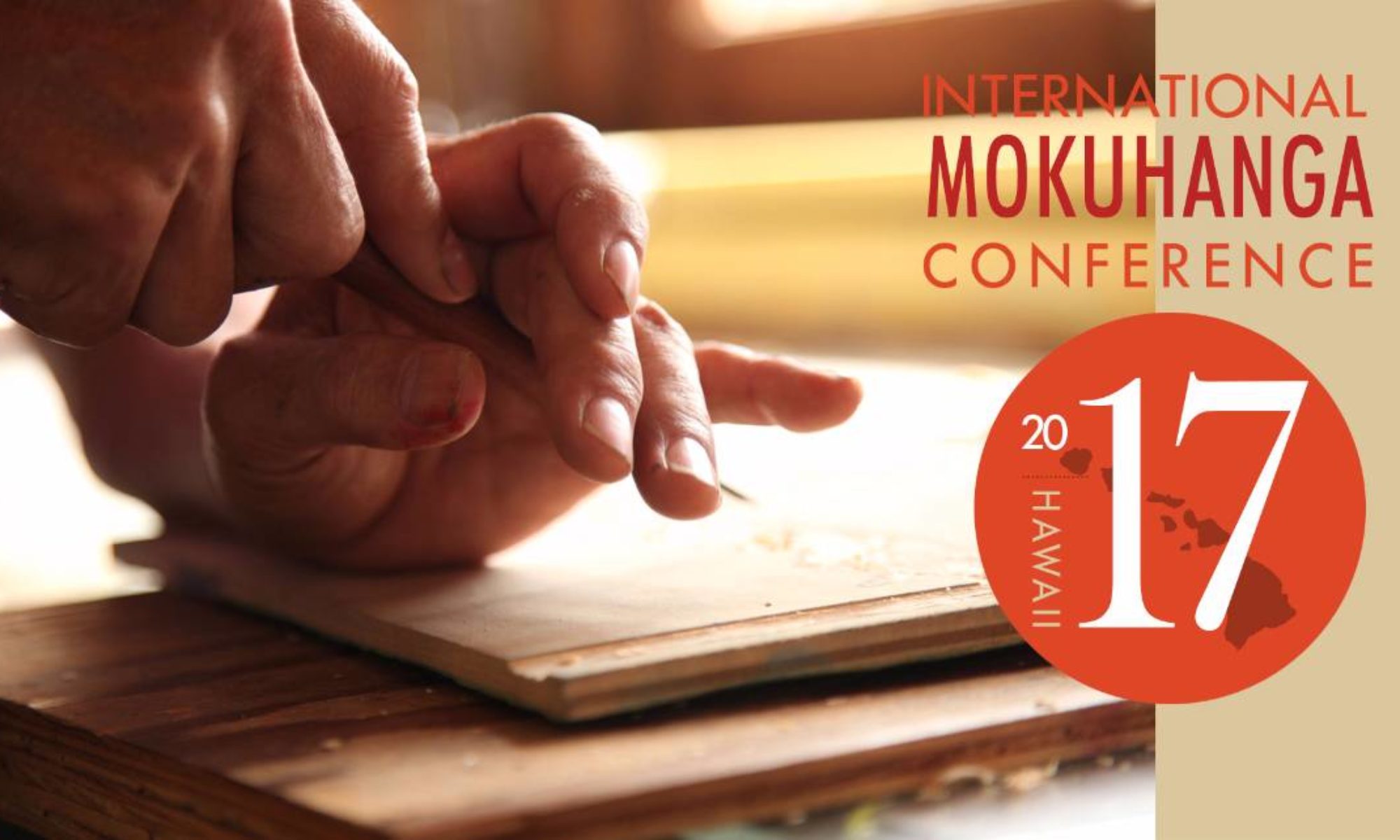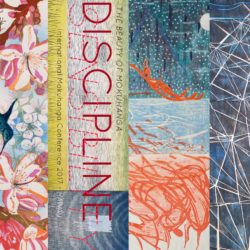Five demonstrations by expert practitioners represented a range of tools, materials and techniques within and expanding the scope of mokuhanga. The sharing and transmission of practical information about mokuhanga was an important part of IMC2017.
HIDEHIKO GOTO
Hidehiko Goto was born in Kokura, Fukukoka prefecture in 1953. After college (wood sculpture course), he studied printing and the baren under Kikuo Gosho, a printmaker, and Matashiro Uchikawa, an ukiyo-e printer. In 1979, he established the baren studio KIKUHIDE. He has been engaged in the planning and development of tools related to the baren as well as in providing direction on the baren for universities, museums and mokuhanga courses. In 2012, he started BAREN-JUKU, a baren class in Ginza, while also making mokuhanga prints as an artist.
To make a much wider audience aware of the baren, the well-known printing tool for mokuhanga, this project aims to introduce how to make the baren where there is no opportunity to easily observe its making. • General information about the baren • Varieties of baren coils and differences in texture • Bamboo sheath (kashirodake), essential materials for making the baren • Inner coil of the baren: 2-strand, 8-strand, 12-strand and 16-strand (by demonstration) • Hard external layer of the baren (ategawa), made by building up layers of washi • Recovering the baren (by demonstration) • How to use the baren in printing
SHOICHI KITAMURA
Shoichi Kitamura graduated from the mokuhanga course at Kyoto Seika University. He studied under Osamu Horita, a carver. He has since participated in Nagasawa Art Park as an instructor. He has also participated in a mokuhanga project at Singapore Tyler Print Institute and collaborated with local artists in Melbourne. He opened his own mokuhanga studio in Yamashina, Kyoto, and collaborated with Australian artists. He is a member of the Kyoto Mokuhanga Craftsman Association as well as Vice Branch Chief of the Ukiyo-e Mokuhanga Carving and Printing Preservation Association.
KYOKO HARAI
Kyoko Hirai graduated from Kyoto Seika University (printmaking) in 1996. In 1998, she studied under Keizo Sato, master printer of Sato Mokuhanga Studio in Kyoto. In 2011–2014, she traveled to Thailand, Myanmar and the US to hold demonstrations under the aegis of the Japan Foundation. Hirai became certified as a Kyoto Young Craftsman in 2014. In 2015, she participated in IMPACT9 in Hangzhou. Hirai ran demonstrations and workshops and lectured on ukiyo-e at the exhibition Japanese printmaking – Woodblock and Japanese Paper at Hong Kong Open Printshop in 2016, in addition to teaching at art colleges and high schools.
She demonstrates special techniques such as unmozuri, kinpakuzuri and ukashizuri. 1. Bokashi (kata bokashi, atenashi bokashi) 2. Mica printing (unmozuri) 3. Gold leaf printing (kinpakuzuri/kinpakumaki) 4. Floating print (ukashizuri) Revisiting as well as acquiring such traditional techniques is a way to explore the great wealth of expressive methods that remain embedded in ukiyo-e.
CHEUNG CHUNG-CHU
Established Chinese painter, calligrapher and printmaker, Cheung Chung-chu is one of the founding members of Hong Kong Open Printshop. Awarded first prize at Virtually/Reality, International Exchange of Prints and Digital Images, Estampe Belgium (2003), his works are collected by the Sakimi Art Museum, Japan, the Hong Kong Museum of Art and the National Taiwan Museum of Fine Art. Cheung Chung-chu’s prints, paintings and calligraphy has been shown in numerous national and international exhibitions, including Southern Graphics Council International Conference, San Francisco, US (2014); Kaolin International Ceramic Art Exhibition, Jingdezhen, China (2013); A Tale of Two Cities: A Duet of Hong Kong and Melbourne, Hong Kong Visual Art Centre (2013); Collaborative Printmaking, Hong Kong Heritage Museum (2013); The 11th International Biennial Print and Drawing Exhibition, Taiwan (2010); and International Print Triennial Krakow, Poland (2009). Cheung Chung-chu, a Hong Kong based artist, considers himself a calligrapher, an ink wash painter rather than a printmaker, though he has been working on etching and woodblock printing for decades. The Book of Songs is from the oldest existing collection of Chinese poetry, dating from the 11th to 7th centuries BC. Cheung has chosen the first poem from the collection, “Guan ju” as the motif to develop a series of woodblock prints, and some of the series are in collaboration with chine-collé or etching as well.
CATHERINE KERNAN
Catherine Kernan is co-founder and partner of Mixit Print Studio and is represented by Soprafina Gallery in Boston. She has taught workshops at Anderson Ranch, ANE/MassArt, North Country Studio Workshops, Peregrine Press, Ballinglen Arts Foundation, Oklahoma Arts Institute, Center for Contemporary Printmaking, and MakingArt Safely, among others. Her course teaching includes the SMFA Boston, Wellesley College, RISD, and Mass College of Art and Design. Residencies include the Ballinglen Arts Foundation, Ireland; Anderson Ranch; MacDowell; the White Colony, Costa Rica; and VCCA. Her work is in the collections of, among others, MFA Boston, Cleveland Museum of Art, Boston Public Library, Grunewald Collection, New York Public Library, Detroit Institute of Art, and the Harvard Art Museums. www.catherinekernan.com
Using Akua Intaglio Inks, relief blocks, and some unorthodox monoprinting techniques, this demonstration will challenge and broaden expectations of what a woodblock will yield. A few of the moves this demonstration sequence will cover are how to: 1.) Print the cut-away parts of your block, 2.) Mix inks for viscosity rolls, 3.) Place contiguous colors on a single plate, 4.) Use resist mixtures to overlay layers of colors on a single plate, 5.) Interrupt one block with another to achieve the intersection of the two, and 6.) Use Release Agent as a protective stencil. The long drying time of Akua Intaglio soy-based inks allows unorthodox moves from block to plate, or block to block, and back before any ink hits the paper.

